Now Trending: Blue and White – The Use of Indigo in Contemporary Interiors
PRIMITIVE - Friday, July 31, 2015By Misaki Imagawa
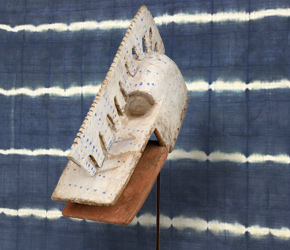 |
|
Imagine walking into a light filled room; the walls are a cool pristine white with the slightest hint of blue. They appear to almost glow. The blue on the walls is actually the reflection coming from the furniture and other decoration in the room. A cobalt throw with thin streaks of white reminds you of a midnight meteor shower. A couch, the color of white sand on a beautiful beach, is lined with deep indigo stitches. The blue and white swirls of a porcelain vase are reminiscent of sunlight on the rippling surface of water. When you look around what do you imagine; a lake shore, a sea, an expanse of clouds above towering skyscrapers? Maybe you see all of them. That is the suggestive power of “blue and white.” It is a timeless color combination with a vibrant history.
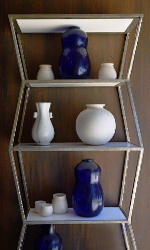 |
|
The blend of blue and white has maintained an elevated status above the circulating trends of interior design. Stated simply, it is a classic palette; and although it is once again being heralded as the palette-in-vogue, the enthusiasm for this color combination is not recent at all. The color blue has been held in the highest regard for thousands of years, all the way back to the ancient Egyptians who acknowledged it as the color of the sea, sky, and heavens. Today, interior professionals are finding all sorts of ways to fuse blue and white combinations into breathtaking designs – and one of the most compelling ways is through the use of indigo, a dark rich blue widely found in ethnographic art and textiles. Since the age of the pharaohs, indigo has been held in the highest regard by cultures all over the world.
Of all blue dyes, indigo is considered the richest and most valuable. It is derived from the indigo plant, Indigofera Tinctoria, which is actually a species of plant from the bean family. The plant grows in tropical and temperate areas of Asia and Africa and has been cultivated for many centuries. Today, a great deal of indigo dye is synthetic; however, look around and you can find products made from the natural dye. Much of what you’ll find falls into the realm of ethnic and tribal art.
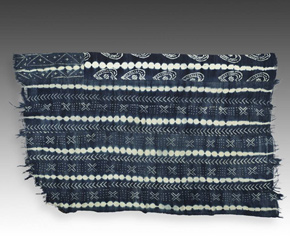 |
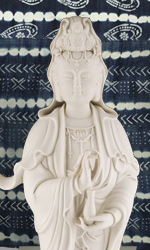 |
||
India is considered the oldest center for the creation of natural indigo dye and has a long history of production and trade reaching as far back as the ancient Greeks. For centuries, indigo was the only quality blue dye available in the world, and as a result held much value and prestige. Many high quality textiles were dyed indigo and decorated with detailed embroidery and other types of adornment. For example, the Naga people of Northeast India have a long history of textile weaving utilizing indigo colored cloth. Sometimes, older textiles can appear modern in their simplicity. This is the case with many Naga blankets, which utilize cowrie shells stitched into simplified designs over deep blue indigo backgrounds. Interestingly, the combination of indigo and cowrie shells can also be found in other parts of the world.
In West Africa, tribes such as the Dogon and Soninke in Mali, Mossi in Burkina Fasso, and Baule in the Ivory Coast have traditionally dyed indigo textiles. Regardless of tribe, dying is a complex process that can take weeks and requires a high degree of expertise. The dying process is actually considered a special ritual in many of these cultures. Techniques were passed on from mother to daughter or father to son. Because there is mystery surrounding the production of the dye, the color indigo became greatly associated with prestige, wealth, and power. In these cultures the color was typically reserved for ceremonial wear. As one Dogon dye artist remarked, "If night hides many secrets, indigo hides just as many."
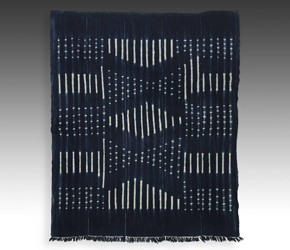 |
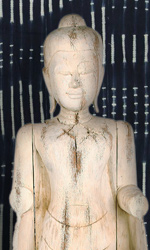 |
||
Take a look at this woman's wrap from the Mossi people in Burkina Faso. The white lines and linear dots form a compelling geometric pattern against the indigo backdrop. Re-purposed as a pillow, wall hanging or throw, it can make an engaging addition to a contemporary interior. Patterns such as these were created by tie dying the cloth or applying starchy pastes that would prevent certain areas from becoming dyed. The resulting white and varying depths of blue had meaningful connotations: white symbolized serenity, insight and wisdom, while blue represented balance and depth.
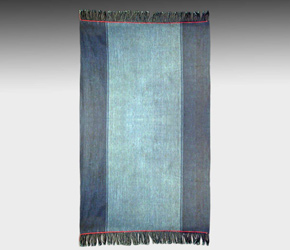 |
|
Halfway across the world, in Indonesia there is also a long history of using indigo dye. In fact, most cloths are dyed using just two colors: indigo and a deep red pigment called morinda. Traditionally, it was believed both dyes possessed magical powers, and accordingly, strict rules and rituals were applied to their use. In particular, the Toba Batak people of Northern Sumatra weave a special ceremonial cloth called Ragidup, which means 'pattern of life.' On this indigo dyed cloth, for instance, the detailed line patterns in the shapes of zigzags and narrow diamonds are a visual language that is 'read' by a specialist during important rites. The cloth is believed to provide guidance and protection.
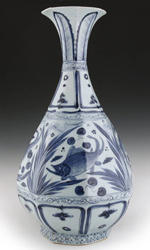 |
|
Switching to another area of the world, China developed blue and white porcelains using indigo to paint the porcelain before firing. The elegant style of this pear shaped vase from the Qing dynasty, called Yuhuchun Ping, has been valued and appreciated in China and more recently the rest of the world for over a thousand years. It is considered a classic in Chinese porcelain ware. The imagery of the fish on this vase is an auspicious symbol of abundance and marital harmony.
The beauty of Chinese ceramic artworks was appreciated outside of China as high aristocrats and royal families in the Middle East and Europe paid exorbitant prices for fine porcelain wares. It was a great symbol of status to dine on porcelain plates or have tea in rooms decorated with Chinese vases. It wasn’t until the 18th century that Europeans were able to successfully emulate the exceptional artistry and craftsmanship inherent in Chinese porcelain. Upon looking at high end brands such as Royal Copenhagen and Wedgewood along with Dutch Delftware, and observing the unwavering demand for Chinese porcelain, it is clear the appreciation for blue and white ceramic artwork has never waned.
Now, imagine another room; one with the same white sofa joined by indigo throw cushions with geo-linear patterns made from cloth woven by the Mossi people of West Africa. The porcelain vase is not just any vase, but one featuring a serene lake scene made in the early Qing dynasty, around 1700, and it’s part of a collection of blue and white porcelain that is elegantly displayed on a steel and white etagere. Next to the sofa is a child’s carousel horse from India. Of course, it is blue and white; and above the white marble fireplace is a blue and white abstract expressionist painting – a masterwork. Blue and white is everywhere, thoughtfully woven into the fabric of the room, telling a compelling story that is left to our imagination. The room has become classic, even if it is eclectic, by virtue of its timeless palette.
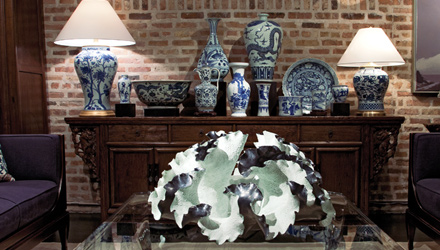 |
Download this Article: Now Trending Blue and White.pdf